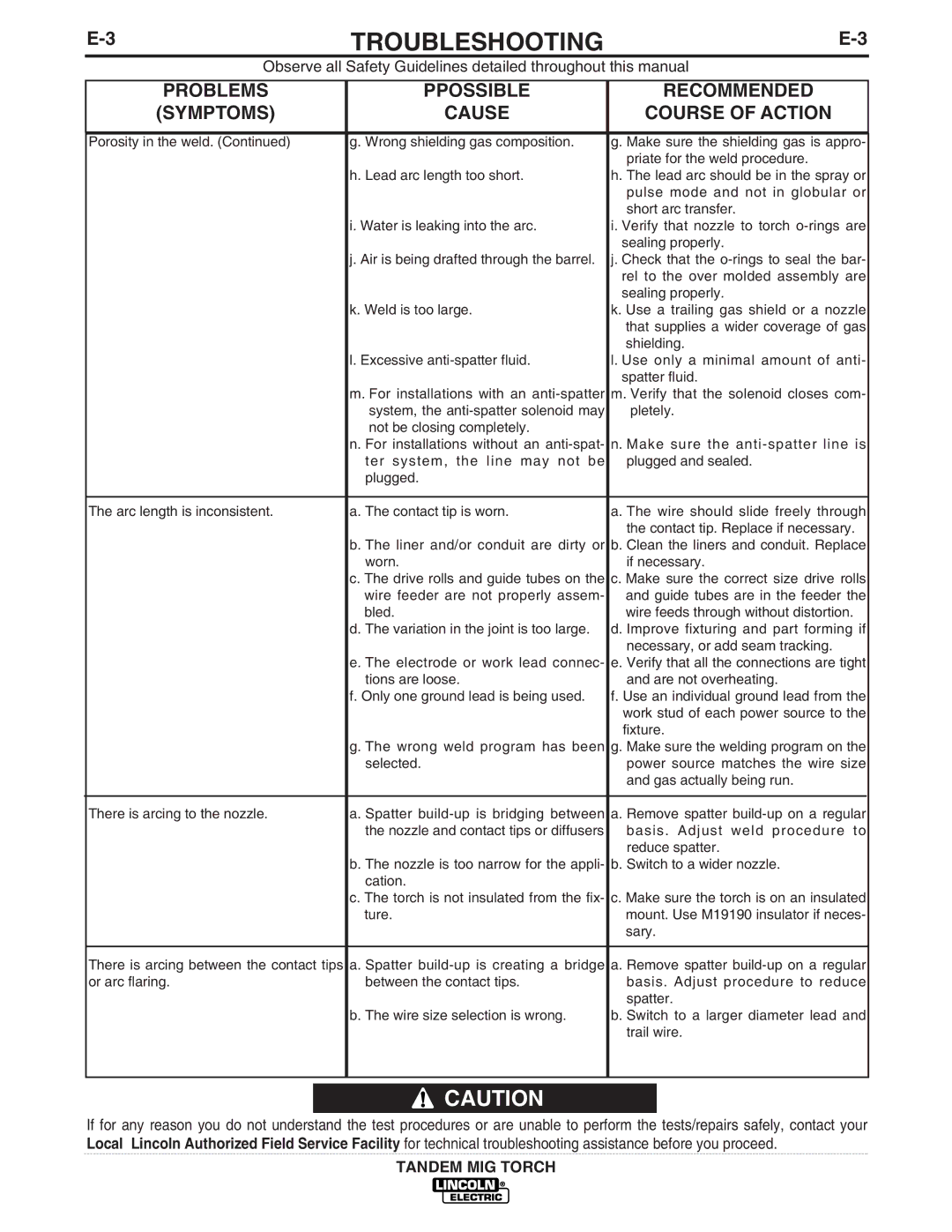
TROUBLESHOOTING | ||
|
|
|
| Observe all Safety Guidelines detailed throughout this manual |
|
|
|
|
PROBLEMS
(SYMPTOMS)
PPOSSIBLE
CAUSE
RECOMMENDED
COURSE OF ACTION
Porosity in the weld. (Continued) | g. Wrong shielding gas composition. | g. Make sure the shielding gas is appro- |
|
| priate for the weld procedure. |
| h. Lead arc length too short. | h. The lead arc should be in the spray or |
|
| pulse mode and not in globular or |
|
| short arc transfer. |
| i. Water is leaking into the arc. | i. Verify that nozzle to torch |
|
| sealing properly. |
| j. Air is being drafted through the barrel. | j. Check that the |
|
| rel to the over molded assembly are |
|
| sealing properly. |
| k. Weld is too large. | k. Use a trailing gas shield or a nozzle |
|
| that supplies a wider coverage of gas |
|
| shielding. |
| l. Excessive | l. Use only a minimal amount of anti- |
|
| spatter fluid. |
| m. For installations with an | m. Verify that the solenoid closes com- |
| system, the | pletely. |
| not be closing completely. |
|
| n. For installations without an | n. Make sure the |
| ter system, the line may not be | plugged and sealed. |
| plugged. |
|
|
|
|
The arc length is inconsistent. | a. The contact tip is worn. | a. The wire should slide freely through |
|
| the contact tip. Replace if necessary. |
| b. The liner and/or conduit are dirty or | b. Clean the liners and conduit. Replace |
| worn. | if necessary. |
| c. The drive rolls and guide tubes on the | c. Make sure the correct size drive rolls |
| wire feeder are not properly assem- | and guide tubes are in the feeder the |
| bled. | wire feeds through without distortion. |
| d. The variation in the joint is too large. | d. Improve fixturing and part forming if |
|
| necessary, or add seam tracking. |
| e. The electrode or work lead connec- | e. Verify that all the connections are tight |
| tions are loose. | and are not overheating. |
| f. Only one ground lead is being used. | f. Use an individual ground lead from the |
|
| work stud of each power source to the |
|
| fixture. |
| g. The wrong weld program has been | g. Make sure the welding program on the |
| selected. | power source matches the wire size |
|
| and gas actually being run. |
|
|
|
There is arcing to the nozzle. | a. Spatter | a. Remove spatter |
| the nozzle and contact tips or diffusers | basis. Adjust weld procedure to |
|
| reduce spatter. |
| b. The nozzle is too narrow for the appli- | b. Switch to a wider nozzle. |
| cation. |
|
| c. The torch is not insulated from the fix- | c. Make sure the torch is on an insulated |
| ture. | mount. Use M19190 insulator if neces- |
|
| sary. |
|
|
|
There is arcing between the contact tips | a. Spatter | a. Remove spatter |
or arc flaring. | between the contact tips. | basis. Adjust procedure to reduce |
|
| spatter. |
| b. The wire size selection is wrong. | b. Switch to a larger diameter lead and |
|
| trail wire. |
|
|
|
![]() CAUTION
CAUTION
If for any reason you do not understand the test procedures or are unable to perform the tests/repairs safely, contact your Local Lincoln Authorized Field Service Facility for technical troubleshooting assistance before you proceed.
TANDEM MIG TORCH
